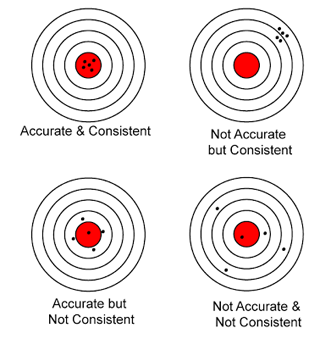Consistency
- Consistency (or precision) is the ability of an instrument in measuring a quantity in a consistent manner with only a small relative deviation between readings.
- The consistency of a reading can be indicated by its relative deviation.
- The relative deviation is the percentage of mean deviation for a set of measurements and it is defined by the following formula:
![]()
Accuracy
- The accuracy of a measurement is the approximation of the measurement to the actual value for a certain quantity of Physics.
- The measurement is more accurate if its number of significant figures increases.
- Table above shows that the micrometer screw gauge is more accurate than the other measuring instruments.

- The accuracy of a measurement can be increased by
- taking a number of repeat readings to calculate the mean value of the reading.
- avoiding the end errors or zero errors.
- taking into account the zero and parallax errors.
- using more sensitive equipment such as a vernier caliper to replace a ruler.
- The difference between precision and accuracy can be shown by the spread of shooting of a target (as shown in Diagram below).

Sensitivity
- The sensitivity of an instrument is its ability to detect small changes in the quantity that is being measured.
- Thus, a sensitive instrument can quickly detect a small change in measurement.
- Measuring instruments that have smaller scale parts are more sensitive.
- Sensitive instruments need not necessarily be accurate.